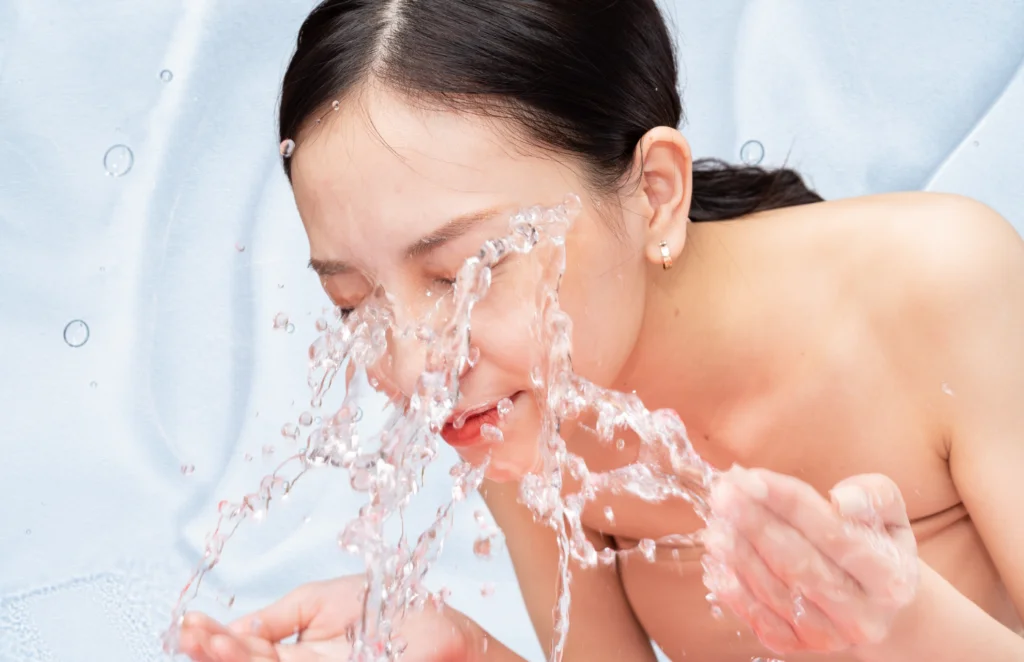
This post is for informational purposes only and is not medical advice. Consult a dermatologist for specific skin concerns. It contains affiliate links, and as an Amazon Associate, I earn a commission at no extra cost to you.
We wash our faces twice a day, making it one of the most essential steps in self-care, just like washing our hands. Our skin is the body’s largest organ and serves as a protective barrier, yet many people unknowingly use the wrong cleansing techniques, leading to irritation, breakouts, and premature aging. Korean dermatologists stress that cleansing is the foundation of skincare, and doing it correctly makes all the difference.
This guide draws from the expertise of two respected Korean dermatologists, Dr. Jung Han Mi and Dr. Lee Sang Wook, who share valuable skincare insights on YouTube. Each focuses on different aspects of cleansing, and together, their advice provides a well-rounded approach to healthy skin.
Dr. Jung’s video shares tips on choosing cleansers based on skin type, proper face-washing techniques, and maintaining skin health. Watch it here.
Dr. Lee emphasizes that proper cleansing preserves the skin’s protective layer by effectively removing impurities without causing damage, tailored to individual skin conditions. Watch it here.
Inspired by their expert recommendations, I recently experimented with refining my cleansing routine—using cleansing milk in the morning and a cleansing balm at night, or double cleansing with a balm and foam when I wear heavy makeup. Let’s explore these dermatologist-approved techniques together and see how small changes can lead to healthier skin!
1. The Importance of Proper Cleansing & Choosing the Right Cleanser
Why Cleansing Matters
Throughout the day, your skin accumulates dirt, oil, and dead skin cells. Without proper cleansing, these impurities clog pores, leading to breakouts, dullness, and premature aging. Korean dermatologists emphasize that using the right cleanser is key to maintaining skin health. Given these expert insights, many people still make common mistakes that can negatively impact their skin. Let’s take a look at some of the most frequent cleansing errors and how to avoid them.
Common Face Washing Mistakes
- Using the wrong cleanser for your skin type: Popular does not mean suitable.
- Washing with hot water: Strips natural oils, causing dryness and irritation. Many Korean dermatologists, including Dr. Lee, recommend using lukewarm water instead of hot water, as it helps maintain the skin’s moisture barrier.
- Over-cleansing or under-cleansing: Too much cleansing damages the skin barrier; too little leads to buildup.
- Skipping morning cleansing: Even if you don’t wear makeup, your skin produces oil overnight.
2. How to Choose the Right Cleanser for Your Skin Type
Your skin’s needs change with weather, hormones, and lifestyle. Dr. Jung explores this in her video and recommends adjusting accordingly Watch this part of her video here
Mild vs. Strong Cleansers
- Morning cleansing: Use mild, slightly acidic cleansers when not wearing makeup to remove overnight sebum.
- Double cleansing: Use stronger cleansers after long periods outdoors or heavy makeup.
- Seasonal changes: Use gentle, slightly acidic cleansers in winter and stronger, mildly alkaline cleansers in summer.
- Combination skin: Use different cleansers for different areas (mild for cheeks, stronger for T-zone).
With this in mind, let’s break down an effective, dermatologist-approved face-washing routine for both morning and night.
3. The Best Face Washing Routine
Morning Cleansing Routine
- Use a mild, slightly acidic cleanser (e.g., cleansing milk) to remove overnight oil.
- Rinse with lukewarm water to avoid stripping the skin.
- Pat dry with a clean, soft towel (don’t rub!).
Evening Cleansing Routine (Double Cleansing Method)
- Step 1: Use an oil-based cleanser or cleansing balm to remove makeup and sunscreen.
- Step 2: Follow with a water-based cleanser to remove leftover residue.
- Rinse with lukewarm water and gently pat dry with a clean towel.
Building on this, incorporating small yet effective cleansing habits can make a significant difference. Here are some expert-recommended tips from Dr. Jung and Dr. Lee for getting the most out of your routine.
Expert Tips for Effective Cleansing
- Wash hands before touching your face.
- Foam up the cleanser before applying.
- Massage gently in circular motions for 1 minute per step.
- Use fingertips (not palms) for a gentle cleanse.
- Avoid harsh scrubbing—it damages the skin barrier.
- After cleansing, it’s essential to moisturize right away to lock in hydration and maintain the skin’s moisture barrier.
Beyond technique, the ingredients in your cleanser play a crucial role in maintaining healthy skin. Let’s explore which ingredients to look for based on your skin type.
4. Understanding the Role of Ingredients in Cleansers
Key Ingredients to Look For:
- Hydrating: Hyaluronic acid, ceramides, glycerin (for dry skin)
- Oil-controlling: Salicylic acid, tea tree oil (for oily skin)
- Barrier-repairing: Niacinamide, centella asiatica (for sensitive skin)
Foam Quality & Cleansing Power
- Dense, rich foam → Stronger cleansing power (better for oily skin).
- Light, minimal foam → Gentler (best for dry or sensitive skin).
Skin is constantly changing due to factors like weather, hormones, and lifestyle. Given these fluctuations, adjusting your cleansing routine accordingly can help maintain optimal skin health.
5. Sensitive Skin Cleansing Tips
Dr. Lee emphasizes the importance of a gentle yet effective cleansing routine for sensitive skin. Watch this part of his video here. He highlights the need to avoid harsh ingredients, use low-pH cleansers, and adopt techniques that minimize irritation.
- Avoid harsh soaps & alkaline cleansers.
- Use low-pH cleansers (4.5–5.5) to maintain skin health.
- Enzyme cleansers are a great alternative. A highly rated option is the Anua Rice Enzyme Brightening Cleansing Powder (available on Amazon), which gently exfoliates with papain enzymes, brightens with rice extract, and strengthens the skin barrier with ceramides.
- Double cleanse with a gentle balm & water-based cleanser to avoid irritation.
- After cleansing, it’s essential to moisturize right away to lock in hydration and maintain the skin’s moisture barrier.
After learning about these expert-backed techniques, I decided to reassess my own cleansing routine. Here’s what I discovered through my personal skincare experiment.
Final Thoughts and My Skincare Experiment
For years, I stuck to the same cleansing routine without giving it much thought. In my 20s and 30s, I had combination skin with an oily T-zone and wore heavy makeup for long hours. Back then, I didn’t realize how much my cleansing habits affected my skin’s health. But as I’ve gotten older, I’ve noticed significant changes—my skin isn’t as oily anymore, and I don’t wear as much makeup since I work from home.
Now, I’ve become more mindful of my cleansing routine, adjusting it based on my skin’s changing needs. Just as Korean dermatologists recommend, I’ve switched to mild, acidic cleansers in the morning to maintain hydration and stronger cleansers in the evening to remove impurities effectively. I’ve personally tried this cleansing technique for a month, and I’ve noticed less irritation. My skin feels softer, more hydrated, and never tight or stripped after cleansing. The IsNtree Yam Root Vegan Milk Cleanser leaves my skin feeling smooth and refreshed, while the Pyunkang Yul Deep Clear Cleansing Balm melts away makeup effortlessly without dripping down my hands as I massage it in. It aligns with what Dr. Lee and Dr. Jung mention in their video about gentle cleansing.
If you’ve noticed changes in your skin over the years, it might be time to reassess your cleansing routine. Using the right cleanser for the time of day and adjusting for seasonal shifts can make a big difference. Two great products I’ve been trying are (both available on Amazon):
- IsNtree Yam Root Vegan Milk Cleanser: A nourishing, lightweight cleanser that gently removes impurities while keeping the skin hydrated.
- Pyunkang Yul Deep Clear Cleansing Balm: A silky balm that melts away makeup and sunscreen while soothing the skin.
Cleansing is an essential step in skincare, and many dermatologists suggest that the right approach may lead to healthier-looking skin over time. Whether you’re dealing with dryness, excess oil, or just looking to refine your routine, making small changes can lead to healthier, more balanced skin.

